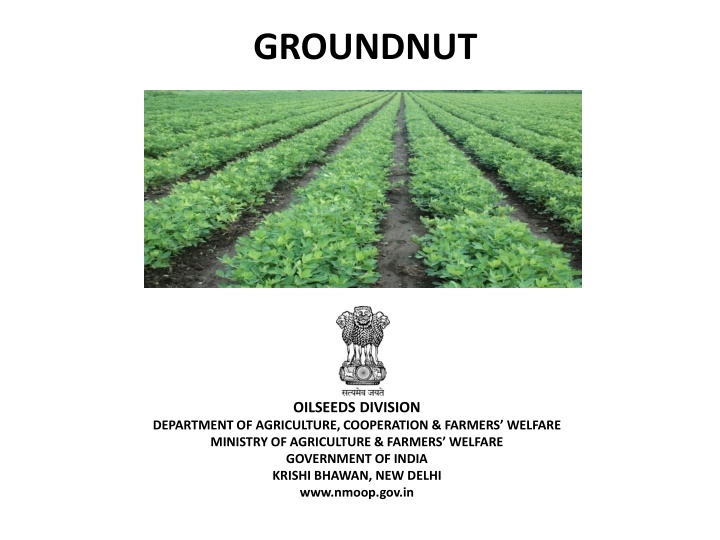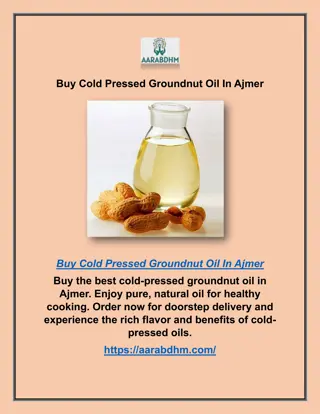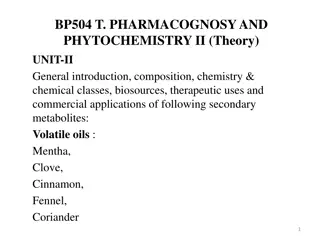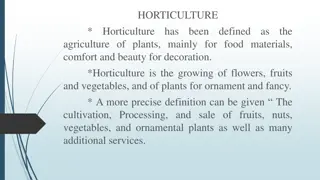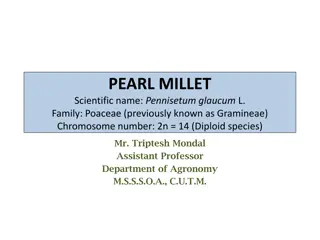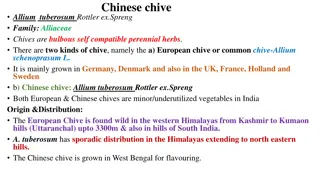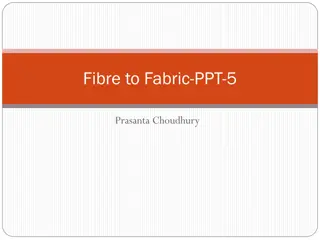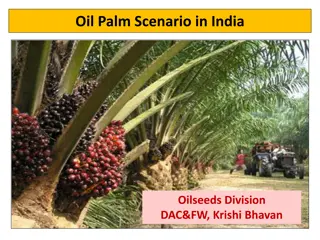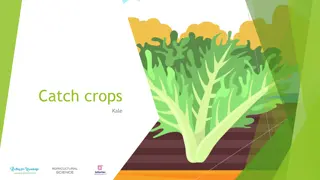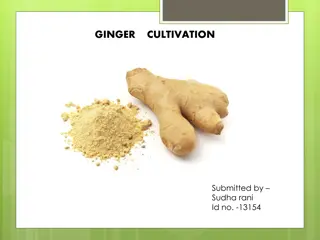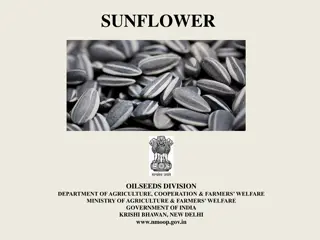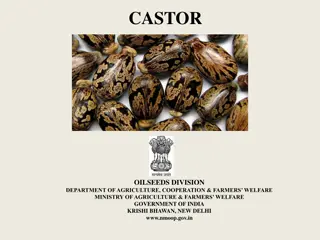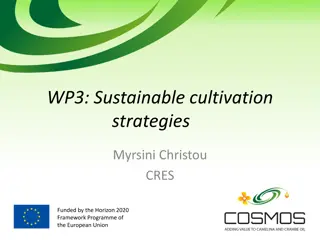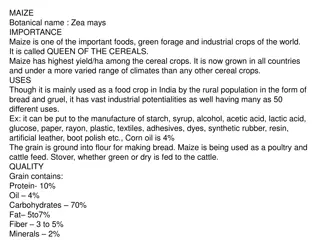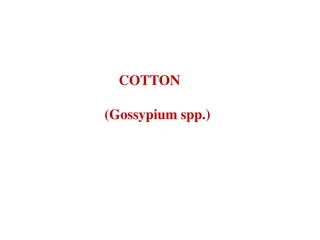Groundnut Cultivation Overview in India
Groundnut, scientifically known as Arachis hypogaea, is a crucial oilseed crop extensively cultivated in India. This crop requires warm and moist conditions, sandy-loam soil, and specific sowing times for optimal growth. The botanical description, global and national scenario, along with area, production, and yield trends provide valuable insights into groundnut cultivation.
Download Presentation

Please find below an Image/Link to download the presentation.
The content on the website is provided AS IS for your information and personal use only. It may not be sold, licensed, or shared on other websites without obtaining consent from the author.If you encounter any issues during the download, it is possible that the publisher has removed the file from their server.
You are allowed to download the files provided on this website for personal or commercial use, subject to the condition that they are used lawfully. All files are the property of their respective owners.
The content on the website is provided AS IS for your information and personal use only. It may not be sold, licensed, or shared on other websites without obtaining consent from the author.
E N D
Presentation Transcript
GROUNDNUT OILSEEDS DIVISION DEPARTMENT OF AGRICULTURE, COOPERATION & FARMERS WELFARE MINISTRY OF AGRICULTURE & FARMERS WELFARE GOVERNMENT OF INDIA KRISHI BHAWAN, NEW DELHI www.nmoop.gov.in
BOTANICAL DESCRIPTION Family :Leguminoceae/(Fabaceae) Sub-family :Papilionoideae Common Name: Groundnut Scientific Name: Arachis hypogaea L Origin: Northern Argentina and South Bolivia and Brazil in which majority of the species are found. Bolivia has the second largest number of species follow Paraguay, Argentina and Uruguay.
SEASON AND CLIMATE Warm and moist conditions are highly congenial for groundnut cultivation. Temperature, light intensity, rainfall and humidity significantly influence groundnut. Optimum temperature of 25-35 C is required for good germination, flowering and pod formation. Sandy-loam soils rich in organic matter is considered best for the crop. Sowing time of kharif groundnut is June to July subject to onset of monsoon and rabi groundnut is November as well as summer groundnut February to March the productivity of 3
CROP DESCRIPTION Arachis species belongs to family Leguminoceae (Fabaceae) sub-family Papilionoideae Flowers borne on axils of leaves on branches Self-pollinated with some cross pollination (0-6% ) by bees Elongated gynophores develop into pods Pods contain 2-5 seeds/kernel Kernel weight ranges from 0.15 to >1.3 g/kernel Virginia / runner types are spreading in nature and suitable for rainfed condition Valencia / Spanish type are erect in nature and more suitable for irrigated conditions Oil contents varies from 42 to 55 % of kernel/seeds 4
GLOBAL SCENARIO (2013-16) Country Avg. Area (lakh ha) 46.27 49.45 25.43 5.30 18.64 8.90 5.90 9.30 7.47 4.44 66.36 247.47 Avg. Production (lakh tonnes) 166.33 79.61 31.37 23.21 15.32 13.78 11.43 8.17 3.43 6.09 59.65 418.39 Avg. Yield (Kg/ha) 3595 1610 1233 4376 822 1549 1939 878 460 1370 899 1691 China India* Nigeria USA Sudan Myanmar Indonesia Senegal Niger Cameroon Others World Source: FAO/USDA. *As per the estimates of DES, DAC&FW 5
NATIONAL SCENARIO (2013-16) State Avg. Area (lakh ha) Avg. Production (lakh tonnes) Avg. Yield (Kg/ha) 15.51 10.65 4.94 3.44 6.34 2.25 31.66 9.44 9.92 9.01 5.38 3.47 2.92 5.00 2041 886 2009 2618 850 1538 1096 1492 Gujarat AP Rajasthan Tamil Nadu Karnataka MP Maharashtra 2.67 3.35 Others 49.15 76.80 1563 All India 6
AREA, PRODUCTION AND YIELD TRENDS 16.00 14.00 12.00 10.00 Area in million ha 8.00 Production in million tonnes Yield in qtl/ha 6.00 4.00 2.00 0.00 1950-51 1960-61 1971-72 1980-81 1990-91 2000-01 2010-11 2015-16 7
HIGHER YIELD AND BETTER QUALITY IN RABI/SUMMER States Area (Lakh ha) Kharif 2015 Prod. (Lakh tonnes) Kharif 2015 Yield (Kg/ha) Kharif 2015 Rabi/ summer 2015-16 Rabi/ summer 2015-16 Rabi/ summer 2015-16 AP 6.82 0.93 5.98 2.04 877 2194 Gujarat 13.55 0.59 22.41 1.17 1654 1983 Karnataka 4.10 1.81 2.73 2.12 666 1171 Maharashtra 1.86 0.54 1.81 0.56 973 1037 Tamil Nadu 2.11 1.40 4.76 4.06 2250 2900 Telangana 0.13 1.14 0.21 1.85 1615 1623 West Bengal 0.03 0.82 0.02 1.98 960 2415 9.33 0.39 15.48 0.52 1659 1333 Others* 37.93 7.62 53.40 14.30 1408 1877 All India *Includes major Kharif groundnut States of Rajasthan and MP. 8
POTENTIAL DISTRICTS State Potential district (>50,000 ha area) Anantpur, Chittoor, Kurnool, YSR Kadapa, AP (04) Gujarat (08) Junagadh, Bhavanagar, Porbandar, Kutch, Sabarkantha Jamnagar, Rajkot, Amreli, Karnataka (07) Chitradurga, Tumkur, Gadag, Bijapur, Belgaum, Bellary, Koppal. Maharashtra (02) Kolhapur, Satara Rajasthan (02) Bikaner, Jaipur Thiruvanamalai, Viluppuram, Vellore Tamil Nadu (03) Telangana (01) Mahabubnagar 9
STATE WISE YIELD GAP UNDER FLDs (IN KHARIF) SAY FLD Kharif- 2013 1722 1873 Yield Gap (%) 93 -45 Varieties used in FLD during Kharif 2013 State AP Gujarat 892 2716 K-6, Dharani GJG-9, GJG-17, GJG-22 Chintamani-2, TPG-39, JSP- 39, Dh-36, GPBD-5 AK-303, TGK-Bold, Phule Unnati, JL-501, Phule-6021, TAG-24, KDG-128 Karnataka 863 1660 92 Maharashtra 1248 2417 94 Rajasthan 1992 2931 47 TAG-24, Mallika West Bengal 917 1982 116 TAG-24, TG-51 K-6, Dharani All India 1764 2021 15 10
STATE WISE YIELD GAP IN RABI/SUMMER SAY FLD Yield Gap (%) Varieties used in FLD during Rabi 2012-13 State 1906 2787 46 Kadari-6, Kadari-9, Harithandra, Dharani, TCGS-1043, Anantha 26 GJG-31, TG-37-A, 275 GPGD-5, GPGD-4, Dh-216, Kadari- 9, Dh-101, TGLPS-3, Chintamani-2 56 JL-501, TPG-41, Phule-6021, TKG- Bold 106 TG-37-A -40 VRI (Gn)-6, 23 TG-24, TG-51 46 AP 2013 760 2535 2851 Gujarat Karnataka 1455 2272 Maharashtra 1258 2998 2585 1812 2593 2130 3190 2654 Rajasthan Tamil Nadu West Bengal All India 11
POPULAR VARIETIES S. No. State Varieties 1 AP K-6,K-9, TMV-2, TAG-24, Narayani, Dharani, ICGV-91114, Anantha, TCGS-1043 2 Gujarat GG-20, GG-11, GG-2, TAG-24, TG-37-A, TG-38, GAUG-10, GJG-9, GJG-17, GJG-22, GJG-31 3 Karnataka TMV-2, GPBD-4, GPBD-5, K-6, TG-37-A, TAG-24, Chintamani-2, TPG-39, JSP-39, Dh-36, ICGV- 91114, K-9, Dh-216 4 Maharashtra K-6, TAG-24, JL-24, AK-303, JL-501, TKG-Bold, Phule Unnati, Phule-6021 5 Rajasthan TAG-24, Malika GPBD-4, Pratap Raj Mungphalli 6 Tamil Nadu TMV-2, TMV-7, K-6, GPBD-4, VRI-2, VRI-3, CO(Gn)-4, VRI(Gn)-6 12
PACKAGE AND PRACTICES Sandy-loam soil rich in organic matter is best. Use of well decomposed FYM @ 10 tonnes /ha. Broad-Bed-Furrow System for yield improvement. Sowing of Kharif groundnut in June to July subject to receipt of rains; Rabi November; Summer February/March. Seed rate of 100-110 kg pod /ha. for bunch type and 95-100 kg pod /ha. for Spreading type. Every one tonne of groundnut pods removes 63 kg N, 11 kg P2O5, 46 kg K2O, 27 kg CaO and 14 kg MgO . 13
PACKAGE AND PRACTICES (contd) Water Management Crop is largely (80%) cultivated under rainfed conditions during kharif. Crop could withstand a dry spell of 25 days after emergence. Rainfall/protective irrigation is necessary at flowering (20-40 DAS), pod formation (40-70 DAS) and pod filling (70-100 DAS). Sprinkler irrigation best suited for sandy soils. Eight irrigations are adequate for optimal yield during Rabi / Summer season. Drip irrigation increases yield (40-50%), quality, and saves water (25-40%). 14
PACKAGE AND PRACTICES (contd) Water Management (contd) Adopting right spacing between rows and within the row Mulching the soil surface in between rows with crop residue material like straw etc to prevent the germination of weed seeds Adoption of crop rotation and intercropping Two hand weeding, first around 20 days after sowing and 2nd at about 35 days after sowing Inter-culture starts around 10 days after emergence and continues up to 35 DAS at 7 10 days interval 15
PACKAGE AND PRACTICES (contd) Insect/Pest Name pests Scientific name Yield losses (%) Leaf Miner Aproaererma modicella (Deventer) 16-92 Tobacco Caterpillar Spodoptera litura (Fab.) 15-30 Hairy Caterpillars Amsacta albistriga (Walker), A. moorei (Butler) and Spilosoma obliqua (Walker) 26-100 Thrips Caliothrips indicus Bagnell, Frankliniella schultzei Trybom, Thrips palmi Karny and Scirtothrips dorsalis Hood 15-28 Aphids Aphis craccivora Koch Up to 40 Leafhoppers/ Jassids Empoasca hortensis Lindb. kerri Pruthi, Balclutha 9-22 White grub Holotrichia consanguinea Blanch and H. serrata (Fab.) 20-100 16
PACKAGE AND PRACTICES (contd) Insect/Pest (contd) Name pests Collar rot Stem rot Scientific name Aspergillus niger van Tieghem. Sclerotium rolfsii Sacc. Teleomorph: Athelia rolfsii (Curzi) Tu & Kimbrough. Cercospora arachidicola Teleomorph: Mycospharella Deighton) Puccinia arachidis Speg. Alternaria alternata, A. tenuissima and A. Arachis Peanut Bud Necrosis Virus (Tospovirus) Yield losses (%) 28 47 27 Early Leaf Spot S. Hori. Up to 60 17 arachidis Rust Alternaria Leaf Blight & Leaf Spot Peanut Bud Necrosis Disease Root knot 10-52 up-to 22 30-90 Meloidogyne arenaria, M. hapla and M. Javanica Tylenchorhynchus Brevelineatus 21.6 Kalahasti Malady 40-50
PACKAGE AND PRACTICES (contd) IPM Deep ploughing during April-May to expose pupae to sunlight and predatory birds. Clean cultivation by rouging out weed hosts and off type of plants. Growing of resistant varieties. Install pheromone traps @ 10 traps/ha for Spodoptera and Helicoverpa and 25 traps/ha for leaf miner.Erect bird perches @ 10-12/ha. Spray neem oil @5ml/lt water along with suitable surfactant like soap powder @ 1g/lt or NSKE 5% . Release Trichogramma chilonis @ 50000/ha, two times at 7- 10 days interval followed by release of Bracon hebetor @ 5000/ha two times at 7-10 days against Leaf Miner and Defoliators. 18
PACKAGE AND PRACTICES (contd) Inter-croppings Intercropping system States Groundnut + Red gram AP, Gujarat, Karnataka, MP, Groundnut + Cotton Karnataka and Tamil Nadu Groundnut + Sorghum/Ragi Karnataka and Maharashtra Groundnut + Pearl Millet AP and Rajasthan Groundnut+Cowpea/Blackgram/ Greengram AP and Tamil Nadu Groundnut + Castor AP, Gujarat and Tamil Nadu Groundnut + Sesame/Sunflower Gujarat, MP, Tamil Nadu and Rajasthan Groundnut + Soybean MP 19
MSP Vs MARKETING PRICES State/MSP Avg. Price of November and December 2013 2014 4000 4000 2015 4030 MSP (Rs. / qtl.) AP 4000 4100 4400 Gujarat 3390 3812 4042 Karnataka 2668 3000 3403 Rajasthan 3580 3475 3898 Tamil Nadu 4437 3445 3520 20
EXPORTS / DEMAND (Quantity in tonnes and value Rs. in crores) Products 2013-14 2014-15 Qty Value Qty Value Groundnut 509750 3187.66 708390 4675.38 Food products 7944 71.46 13096 119.02 Groundnut oil 6511 58.94 38952 343.15 Oil cakes 8711 22.72 4147 21.90 Total 532916 3340.78 764585 5159.45 Source: Oilseeds statistics A compendium 2015 from ICAR- IIOR 21
NUTRITIVE VALUE Groundnut is considered as low sodium food. Groundnut are free from cholesterol and contains less than 20% saturated fatty acid hence heart friendly. Groundnut seed contains 44-55% oil and 22-30% protein on a dry seed and is a rich source of mineral (phosphorus, calcium, magnesium and potassium) and vitamins E, K and B group Groundnut oil also contains some palmitic acid, arachidonic acid, behenic acid, lignoic acid and other fatty acids Groundnut has lowest Glycaemic index (GI) a measure of the rate at which carbohydrate from a particular food break down and release glucose in blood stream Groundnut contains 26% protein, which is higher than egg, meat, fish and dairy products
RESEARCHABLE ISSUES Development of varieties / technologies for control of Peanut Bud / Stem Necrosis/Clamp virus disease. The old varieties like TMV-2 & TAG-24 in Southern states and GG-20 in Gujarat are still preferred because of their better performance under adverse weather conditions and market preference. Use of cytoplasm/gene from such varieties for development of high yielding varieties. Development of effective control measures for white grub for Rajasthan and Gujarat Resistant varieties/technology for aflatoxin management. 23
ISSUES / ACTIONABLE POINTS Development of varieties / technologies for control of Peanut Bud / Stem Necrosis /Clamp virus disease of groundnut. Development of substitute for the old varieties like TMV-2 & TAG-24 in Southern states and GG-20 in Gujarat which are preferred because of their better performance under adverse weather conditions and market preference. Development of effective control measures for white grub in Gujarat, Rajasthan and UP. Resistant varieties / technology for aflatoxin management.
